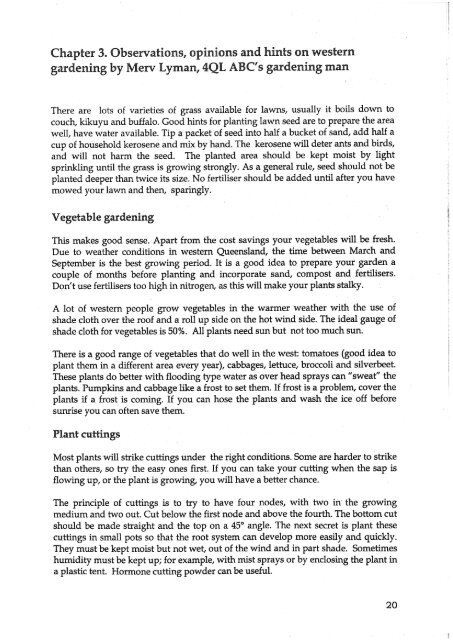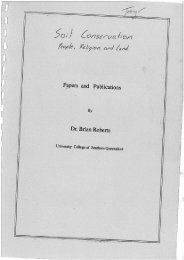western-queensland-gardening-guide.pdf - South West NRM
western-queensland-gardening-guide.pdf - South West NRM
western-queensland-gardening-guide.pdf - South West NRM
Create successful ePaper yourself
Turn your PDF publications into a flip-book with our unique Google optimized e-Paper software.
Chapter 3. Observations, opinions and hints on <strong>western</strong><br />
<strong>gardening</strong> by Men Lyman, 4QL ABC's <strong>gardening</strong> man<br />
,<br />
There are lots of varieties of grass available for lawns, usually it boils down to<br />
couch, kikuyu and buffalo. Good hints for planting lawn seed are to prepare the area<br />
well, have water available. Tip a packet of seed into half a bucket of sand, add half a<br />
cup of household kerosene and mix by hand. The kerosene will deter ants and birds,<br />
and will not harm the seed. The planted area should be kept moist by light<br />
sprinkling until the grass is growing strongly. As a general rule, seed should not be<br />
planted deeper than twice its size. No fertiliser should be added until after you have<br />
mowed your lawn and then, sparingly.<br />
Vegetable <strong>gardening</strong><br />
This makes good sense. Apart from the cost savings your vegetables will be fresh.<br />
Due to weather conditions in <strong>western</strong> Queensland, the time between March and<br />
September is the best growing period. It is a good idea to prepare your garden a<br />
couple of months before planting and incorporate sand, compost and fertilisers.<br />
Don't use fertilisers too high in nitrogen, as this will make your plants stalky.<br />
A lot of <strong>western</strong> people grow vegetables in the warmer weather with the use of<br />
shade cloth over the roof and a roll up side on the hot wind side. The ideal gauge of<br />
shade cloth for vegetables is 50%. All plants need sun but not too much sun.<br />
There is a good range of vegetables that do well in the west: tomatoes (good idea to<br />
plant them in a different area every year), cabbages, lettuce, broccoli and silverbeet.<br />
These plants do better with flooding type water as over head sprays can "sweatff the<br />
plants. Pumpkins and cabbage like a frost to set them. If frost is a problem, cover the<br />
plants if a frost is coming. If you can hose the plants and wash the ice off before<br />
sunrise you can often save them.<br />
Plant cuttings<br />
Most plants will strike cuttings under the right conditions. Some are harder to strike<br />
than others, so try the easy ones first. If you can take your cutting when the sap is<br />
flowing up, or the plant is growing, you will have a better chance.<br />
The principle of cuttings is to try to have four nodes, with two in. the growing<br />
medium and two out. Cut below the first node and above the fourth. The bottom cut<br />
should be made straight and the top on a 45' angle. The next secret is plant these<br />
cuttings in small pots so that the root system can develop more easily and quickly.<br />
They must be kept moist but not wet, out of the wind and in part shade. Sometimes<br />
humidity must be kept up; for example, with mist sprays or by enclosing the plant in<br />
a plastic tent. Ho one cutting powder can be useful.
















